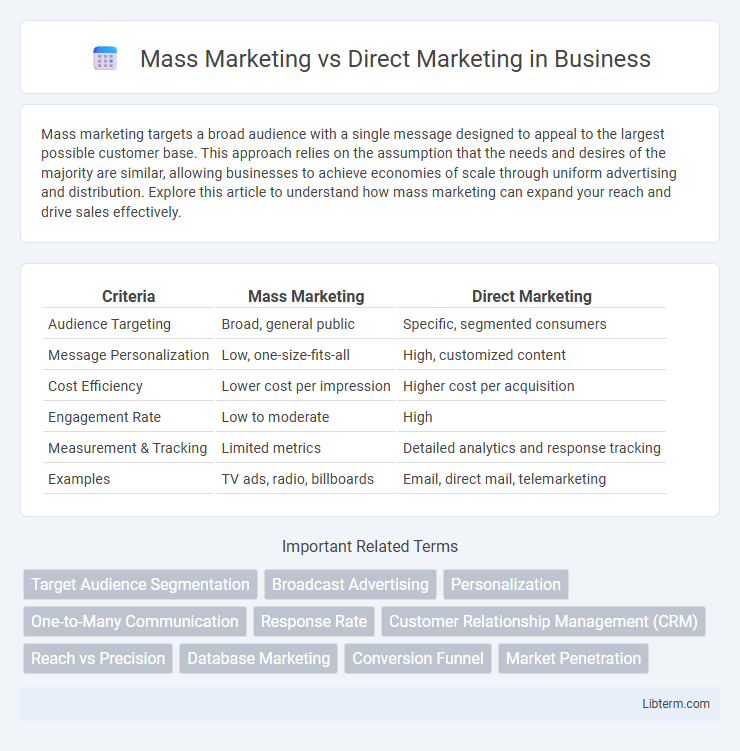Mass marketing targets a broad audience with a single message designed to appeal to the largest possible customer base. This approach relies on the assumption that the needs and desires of the majority are similar, allowing businesses to achieve economies of scale through uniform advertising and distribution. Explore this article to understand how mass marketing can expand your reach and drive sales effectively.
Table of Comparison
| Criteria | Mass Marketing | Direct Marketing |
|---|---|---|
| Audience Targeting | Broad, general public | Specific, segmented consumers |
| Message Personalization | Low, one-size-fits-all | High, customized content |
| Cost Efficiency | Lower cost per impression | Higher cost per acquisition |
| Engagement Rate | Low to moderate | High |
| Measurement & Tracking | Limited metrics | Detailed analytics and response tracking |
| Examples | TV ads, radio, billboards | Email, direct mail, telemarketing |
Understanding Mass Marketing: An Overview
Mass marketing targets a broad audience using uniform messages to maximize reach and brand visibility, leveraging channels like television, radio, and billboards. This approach aims to appeal to the general population without segmenting consumers based on specific characteristics or behaviors. Companies such as Coca-Cola and Procter & Gamble exemplify mass marketing by promoting products that fulfill universal needs and preferences across diverse demographics.
What is Direct Marketing? Key Concepts
Direct marketing targets specific audiences using personalized messages through channels such as email, telemarketing, and direct mail to generate immediate responses. It emphasizes measurable outcomes by tracking customer engagement and conversion rates, enabling businesses to refine campaigns based on real-time data. Key concepts include audience segmentation, personalized communication, and call-to-action strategies designed to drive direct sales or customer interaction.
Core Differences Between Mass and Direct Marketing
Mass marketing targets a broad audience through generalized messages aimed at maximizing reach, primarily using traditional media such as TV, radio, and print. Direct marketing involves personalized communication directed at specific customer segments, utilizing channels like email, direct mail, and telemarketing to foster individual engagement and measurable responses. The core difference lies in mass marketing's focus on scale and brand awareness versus direct marketing's emphasis on targeted interaction and conversion tracking.
Audience Segmentation in Mass vs Direct Marketing
Mass marketing targets a broad audience with a uniform message, lacking detailed audience segmentation, aiming for maximum exposure and high reach. Direct marketing employs precise audience segmentation by leveraging data analytics, customer behavior, and demographics to deliver personalized messages that enhance engagement and conversion rates. Effective segmentation in direct marketing results in higher ROI and tailored communication, whereas mass marketing sacrifices personalization for widespread visibility.
Communication Channels: Broad vs Targeted Approaches
Mass marketing relies on broad communication channels such as television, radio, and print media to reach a large audience with a generic message, maximizing exposure but often lacking personalization. Direct marketing leverages targeted approaches like email campaigns, personalized messages, and social media ads, enabling precise audience segmentation and higher engagement rates. The choice between these communication channels significantly impacts the efficiency and ROI of marketing strategies by aligning message delivery with consumer preferences and behaviors.
Cost Implications of Mass and Direct Marketing
Mass marketing generally incurs lower cost per impression due to its broad reach, leveraging economies of scale through mediums like television, radio, and print advertising. Direct marketing, such as email campaigns, telemarketing, or personalized mailers, tends to have higher costs per contact but offers more targeted and measurable outcomes, potentially leading to higher conversion rates and better ROI. Businesses must balance upfront expenses with expected returns, considering mass marketing's extensive but less focused approach against direct marketing's precision and personalization costs.
Measuring Effectiveness: Metrics and KPIs
Mass marketing effectiveness is measured by broad metrics such as total reach, impressions, and market share growth, emphasizing volume and brand awareness. Direct marketing relies on precise KPIs like response rate, conversion rate, customer acquisition cost, and return on investment (ROI) to track individual campaign performance. Comparing these metrics highlights mass marketing's focus on widespread exposure versus direct marketing's emphasis on targeted engagement and measurable outcomes.
Personalization: The Power of Direct Marketing
Direct marketing leverages personalization by targeting specific customer segments with tailored messages, increasing engagement and conversion rates. Mass marketing casts a broad net, often resulting in generic communications that may miss individual preferences. The power of direct marketing lies in its ability to use customer data and insights to deliver relevant, meaningful content that resonates on a personal level.
Suitability by Industry and Business Goals
Mass marketing is well-suited for industries with broad consumer bases such as consumer goods, retail, and entertainment where brand awareness and large-scale reach are primary business goals. Direct marketing fits industries like financial services, real estate, and B2B sectors that prioritize personalized customer engagement, lead generation, and measurable response rates. Businesses aiming for rapid market penetration benefit from mass marketing, while those focusing on customer retention and targeted sales see better results with direct marketing strategies.
Future Trends: Evolving Strategies in Marketing
Mass marketing is shifting towards personalized content through AI-driven data analytics, enabling broader audience reach with tailored messaging. Direct marketing leverages advancements in automation and hyper-targeted campaigns, enhancing customer engagement and response rates. Future marketing strategies will increasingly integrate omnichannel approaches, blending mass appeal with precision targeting for optimized conversion.
Mass Marketing Infographic

 libterm.com
libterm.com